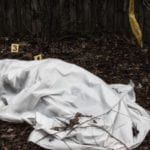 Crime
Crime  Crime
Crime  Technology
Technology 10 Hilariously Over-Engineered Solutions to Simple Problems
 Miscellaneous
Miscellaneous 10 Ironic News Stories Straight out of an Alanis Morissette Song
 Politics
Politics 10 Lesser-Known Far-Right Groups of the 21st Century
 History
History Ten Revealing Facts about Daily Domestic Life in the Old West
 Weird Stuff
Weird Stuff 10 Everyday Products Surprisingly Made by Inmates
 Movies and TV
Movies and TV 10 Actors Dragged out of Retirement for One Key Role
 Creepy
Creepy 10 Lesser-Known Shapeshifter Legends from Around the World
 Animals
Animals 10 Amazing Animal Tales from the Ancient World
 Gaming
Gaming 10 Game Characters Everyone Hated Playing
 Crime
Crime 10 Terrifying Serial Killers from Centuries Ago
 Technology
Technology 10 Hilariously Over-Engineered Solutions to Simple Problems
 Miscellaneous
Miscellaneous 10 Ironic News Stories Straight out of an Alanis Morissette Song
Who's Behind Listverse?

Jamie Frater
Head Editor
Jamie founded Listverse due to an insatiable desire to share fascinating, obscure, and bizarre facts. He has been a guest speaker on numerous national radio and television stations and is a five time published author.
More About Us Politics
Politics 10 Lesser-Known Far-Right Groups of the 21st Century
 History
History Ten Revealing Facts about Daily Domestic Life in the Old West
 Weird Stuff
Weird Stuff 10 Everyday Products Surprisingly Made by Inmates
 Movies and TV
Movies and TV 10 Actors Dragged out of Retirement for One Key Role
 Creepy
Creepy 10 Lesser-Known Shapeshifter Legends from Around the World
 Animals
Animals 10 Amazing Animal Tales from the Ancient World
 Gaming
Gaming 10 Game Characters Everyone Hated Playing
10 of the Weirdest Places That Have Been Preserved
Plenty of historic places have been preserved over the years, such as the Tower of London and George Washington’s Mount Vernon, but it is often surprising to discover some of the history-related venues preserved for patrons to tour. Whether it is a place connected to a shocking crime or an offbeat event, these sites can be major tourist draws. These 10 locales are among the weirdest historic places to be preserved.
Related: Top 10 Attractions To Visit For A Weird Tour Of Europe
10 The Witch House
The Salem Witch Trials, which often resulted in many individuals being executed, were a shocking and tragic chapter of colonial American history. However, hundreds of years later, there’s still a lot of interest in the stories of these people being accused of practicing witchcraft. The Witch House in Salem, Massachusetts, is said to be the last remaining building directly linked to the famous Salem Witch Trials of 1692. And it is open to the public.
The large, ominous-looking gray clapboard house with lattice windows, previously known as the Corwin House, was once the home of Judge Jonathan Corwin (1640–1718), who was one of the two judges conducting examinations of alleged witches during this time. A zealous witch hunter who was scrutinized for using spectral evidence as grounds for convictions, Corwin was connected to the witch crisis on a personal level as well.
Corwin’s mother-in-law was accused of, but never arrested, for witchcraft ,and it was believed that one of his children was afflicted in the witchcraft outbreak. In danger of being demolished to widen a road during the 1940s, citizens raised money to have it moved 35 feet (10.6 meters) back. It opened as a museum in 1948, offering an enlightening view of the daily life of the affluent class in 17th-century New England.[1]
9 Bodie, California
The once thriving gold mining town of Bodie, California, in the Sierra Nevada Mountains, is now considered a ghost town, but during tourist season, it comes to life again. Bodie, which experienced a gold rush in 1875 but was almost completely abandoned by the 1940s, was declared a State Historic Park and a National Historic Landmark in 1962. As a result, Bodie is preserved in a state of “arrested decay.”
One of the most interesting things about this particular ghost town is how many personal belongings were left behind, mainly because it was too expensive for residents to have their possessions taken away when they moved since the location was difficult to reach. Finding old furniture inside the abandoned houses and other remnants of daily life, such as a roulette wheel inside the saloon, make Bodie seem almost like it was frozen in time, giving it more of an eerie and surreal atmosphere than a typical ghost town.[2]
8 Franklin Castle
For all its colorful and esteemed history, the Tiedemann House, nicknamed Franklin Castle along Franklin Avenue in Cleveland, may be best known as a haunted house. The large, stone Victorian eclectic structure was built in the early 1880s by wealthy local businessman Hannes Tiedemann, who had immigrated from Germany.
Tiedemann not only used the home as a residence for himself and his family but also as temporary lodging for friends, family, and newly arrived German immigrants. It was later home to the German-American League of Culture and has since been owned by a number of different people, including Judy Garland’s fifth husband, musician Mickey Deans, who invested heavily in restoring the house. A fire set by an arsonist shortly after Deans sold it in 1999 resulted in more restoration.
Following rumors that had circulated for several years, one owner in the mid-1970s cashed in on the public’s curiosity by offering haunted house tours. One thing that helped to perpetuate the ghost lore was the tragedy associated with the Tiedemann family while living on this property.
Four of the Tiedemann’s children reportedly died in a house that previously occupied the same site where Franklin Castle currently stands. At the end of 2022, the current owners started renting rooms out to overnight guests in this majestic but sinister-looking building, which, according to cleveland.com, was once considered the most haunted house in the city.[3]
7 Minuteman Missile National Historic Site, near Wall, South Dakota
Visitors touring the Minuteman Missile National Historic Site get a look at what life was like in a place that served an important purpose during the Cold War era. During these years, when over 1,000 Minuteman missiles were buried throughout the U.S., teams would monitor classified frequencies, prepared to instantly attack the enemy while sitting in launch command centers like these.
The cramped and seemingly mundane environment of the launch center is a stark contrast to the fearsome reason behind its existence. This place has been impressively preserved since it was deactivated in the mid-1990s. In addition to all the complex equipment, the center is part nostalgia with the vintage coffee pot still sitting in the snack area and reading material like Byte Magazine and very old copies of Reader’s Digest, once used to help cope with what must have been monotonous hours in this impenetrable bunker 80 feet (24 meters) underground.[4]
6 Stavros Niarchos Foundation Parkway in Baltimore
The once grand and opulent Baltimore movie theater called the Stavros Niarchos Foundation Parkway, built in 1915, now looks dilapidated or unfinished to many patrons. Despite the $19 million that was spent on the preservation, it is intended to look the same as it did when abandoned in 1978. This is because of the efforts to preserve this Renaissance Revival–style movie palace in a state of arrested decay.
Some remnants of the venue’s past provide a glimpse into the evolution of the theater over the years, such as the variety of wallpaper sections representing various decades. Many years after the city took possession of the building, architect Steve Ziger got together with his friend Jed Dietz, director of the Maryland Film Festival. They came up with the idea of bringing the structure up to code but mainly leaving it the way it was so the visible changes the venue had been through could tell its own story.
Senior project manager for Southway Builders, George Arendt, was surprised by this plan: “I said, ‘Wait, they just want to leave it as-is?’” The decline is obvious in many ways, such as chipped plaster, faded and mismatched paint, missing ornaments, and a deteriorated sunburst medallion.
While Steve Ziger tried to avoid replicating things that no longer existed, a new marquee was built to replace the old one that came down in 1980. So the result may be an unusual atmosphere to show films, but in addition to the escape of going to the movies, attendees also get to take a trip through history by coming to this legendary theater, which reopened in 2017.[5]
5 Alcatraz
Normally, it might seem odd to preserve an abandoned prison as a museum, but Alcatraz, located on a tiny island just off the coast of San Francisco, has an exceptionally interesting history. Long before the well-known federal penitentiary, which was open from 1934 to 1963, Alcatraz Island served other purposes, housing the first lighthouse on the Pacific coast as well as a fort built during the early 1850s and later as a military prison. It was also occupied by Native Americans from 1969 to 1971 before it became part of the National Park Service unit, opening to the public in 1973.
However, the maximum security prison known as “The Rock” is what it’s best remembered for and is a huge tourist draw. The notorious criminals who did time there, along with famous escape attempts and movies, have all contributed to the curiosity surrounding this iconic former correctional facility. Though some parts of the complex were damaged by fire and graffiti, the main cell block has been stunningly well preserved, giving visitors a realistic idea of what the living conditions were like there for inmates.[6]
4 Glore Psychiatric Museum
Visiting the Glore Psychiatric Museum helps us understand why people were once terrified of mental hospitals. This former mental institution in St. Joseph, Missouri, was known as the State Lunatic Asylum #2 when it opened in 1874. In addition to the devices used at this hospital, such as “restraining belts, ‘early tranquilizers’ (clubs), electroshock superchargers, and doctor-designed ice picks for lobotomies,” there are also replicas of torturous implements on display. These offer a grim look into the history of treatment for the mentally ill and are located in the hospital’s former surgery and outpatient building, sitting outside of the old hospital, which has been converted into a correctional facility.
Among the most interesting exhibits involve hobbies or activities of the asylum’s former patients. Besides the artwork created by patients, there is a display of 108,000 cigarette packs collected by a male patient in hopes of redeeming them for a new wheelchair for the hospital. One glass case shows 1,400 various pieces of metal, including bolts, screws, pins, nails, bottle caps, and buttons, swallowed by a woman who suffered from a compulsive need to swallow metal objects.[7]
3 Death Valley
With spots like Furnace Creek and Devil’s Hole, the extremely hot, dry Death Valley National Park, which lies along the California-Nevada border, has a reputation for its harsh environment. So, with the exception of its mining potential, there’s no wonder that many thought of this place as a vast wasteland. However, in 1994, the California Desert Protection Act was established, turning 3.3 million acres into a national park.
It seems that there are plenty of things in this often brutal place worthy of preservation, including rare plants and animal species. In addition to preserving its natural resources, the formidable Death Valley also retains some intriguing man-made landmarks such as Marble Bath, literally a big claw-footed bathtub filled with marbles, brought to this scorchingly part of the Mojave Desert by someone who must have had an ironic sense of humor.
In addition, Teakettle Junction features a signpost decorated with numerous tea kettles left there by visitors. Some of Death Valley’s most popular attractions include ghost towns and the remains of manufacturing, such as the 19th-century Borax Works and one of the most unexpected sites, a vacation house from the 1920s called Scotty’s Castle.[8]
2 Ohio State Reformatory
Local activists were instrumental in preserving the Ohio State Reformatory. Since purchasing it from the state for $1.00, volunteers have worked at maintaining, repairing, and restoring the former prison. Not only has the site become a tourist attraction, but it served as a filming location for the popular 1994 movie The Shawshank Redemption within the first few years of its closure in 1990. Several other movies had scenes shot there, including Tango and Cash and Air Force One.
The Mansfield-area institution built in 1896 was originally called the Intermediate Penitentiary because its inmates were too old for juvenile corrections facilities, but their offenses were minor compared to the crimes of those sent to the Ohio State Penitentiary. The handsome architecture of the Romanesque-style limestone structure helps to explain its appeal to filmmakers. Architect Levi Scofield succeeded in his goal to give OSR a design that would be “uplifting, inspiring, and intimidating.” Another factor that helps to bring sightseers to OSR is its reputation for being haunted. The venue even offers special ghost tours.[9]
1 Lizzie Borden House
The site of an infamous brutal double murder may seem like an odd choice of venue for something as traditionally relaxing and hospitable as a bed and breakfast, but that’s exactly what’s become of accused murderer Lizzie Borden’s former home. Borden, a 32-year-old Sunday School teacher from a prosperous and respected family, was living in this Fall River, Massachusetts, house with her father Andrew, stepmother Abby, and older sister Emma (away on vacation at the time) when Mr. and Mrs. Borden were both murdered with a hatchet in 1892. Although she was acquitted, the widespread belief that Lizzie Borden was the culprit in this unsolved homicide has persisted over the years.
The Lizzie Borden House (now a bed and breakfast & museum), which offers several different types of tours, including a ghost hunt, is very well preserved. While the decor has been duplicated, the house’s original doors and hardware are still intact. The venue also displays artifacts from the murder case.[10]








